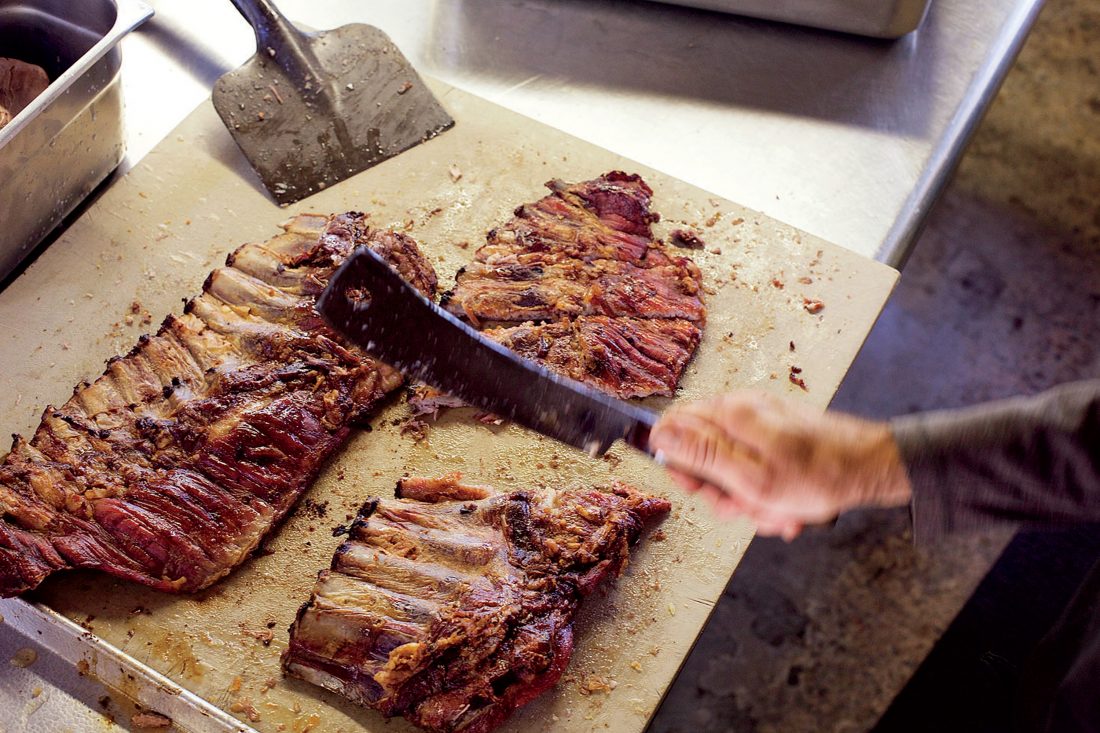Where have you been, sweetheart? That’s what counterperson Rhonda Kirkland asks when I confess that, although Hite’s Bar-B-Que has been stoking pits and stirring hash in West Columbia, South Carolina, since 1957, this is my first visit. She isn’t sassing her way toward a tip. Instead, she wants an honest accounting of how a full-grown man with a nose for smoldering oak and deep family roots in the state has not previously crossed the threshold of this cinder-block standard-bearer to claim a plate of mustard-gilded pork, a tray of cracker-thin skins, and a bowl of funky hash and gummy rice.
I have no answer for her. A hutch of a takeaway, set at the top of a hill, flanked by a few picnic tables, and backed by towering cords of oak, Hite’s is just the sort of joint that eaters like me seek. Three generations of Hites live in the surrounding brick and clapboard bungalows, grouped around a bream-stocked fishing pond. Here on the outskirts of West Columbia, across the river from the state capitol, chickens peck behind a chain-link fence. Goats bleat. Puppies frolic in the bed of a pickup truck. And fathers and sons, with smiles of expectation fixed on their faces, walk hand in hand through the parking lot, toward the smoke that seeps from the eaves of the screen-windowed pit house.
If nearby Piggie Park—the drive-in colossus of West Columbia where Maurice Bessinger once dished retrograde neo-Confederate politics and delicious dirty mustard sauce—is the three-ring Barnum & Bailey Circus of barbecue, then Hite’s, founded just four years later, is an earnest community theater production of Thornton Wilder’s Our Town.
Photo: Margaret Houston
Proprietor David Hite.
1 of 10
Photo: Margaret Houston
2 of 10
Photo: Margaret Houston
3 of 10
Photo: Margaret Houston
4 of 10
Photo: Margaret Houston
5 of 10
Photo: Margaret Houston
Hites018
6 of 10
Photo: Margaret Houston
Hites066
7 of 10
Photo: Margaret Houston
Hites079
8 of 10
Photo: Margaret Houston
Hites095
9 of 10
Photo: Margaret Houston
Hites127
10 of 10
Like many South Carolina joints, including Scott’s in Hemingway and Sweatman’s in Holly Hill, Hite’s began as the weekend-only project of a farmer in need of extra income. The farmer was John D. Hite, who raised minnows, hogs, corn, and sweet potatoes. His grandson, the current proprietor David Hite, is a two-income kind of guy, too, striping asphalt parking lots when he’s not burning piles of oak.
Approach the pit house from the rear and you may stumble on a blazing mountain of wood stacked in an iron frame. Other barbecue houses burn wood in a barrel. David goes simpler still, rendering coals in a modified campfire fashion before shoveling payload after smoky payload under whole hogs and hams that look like they have been varnished with mustard and lacquered with smoke.
Order a sandwich, and you get a chop of lightly sauced ham meat. Order a rib cut, always in perilously short supply, and you win the lottery. Cut from the midsection of a whole hog, your prize will contain a cross section of the best parts of the animal: crispy skin, ropy belly, and eminently gnawable ribs. Along with hash, which looks and tastes like what happens when you run a long-simmered mess of liver and onions through a blender, and a sweet thatch of slaw, which it’s acceptable to ignore, Hite’s serves what the wags call two-hundred-mile barbecue.
In literature, quests demand great perseverance and much travel in exotic locales. Smoked roadside on earthen pits overlaid with bedsprings or wire fencing, barbecue emerged in the early twentieth century as the favored food of Southern travelers. And so it remains. Thanks to a raft of new books and websites, plotting two-hundred-mile barbecue pilgrimages has never been easier. But all that documentation has contributed to a sort of complacency, a shared belief among folk like me, and maybe you, that all the dragons have been slain and all the smoke shacks have been catalogued.
Often, friends or relatives with a barbecue fetish will approach me to confess that they haven’t yet eaten at one of the South’s citadel purveyors. Like Archibald’s Bar-B-Q in Northport, Alabama. Or Helen’s Bar-B-Q in Brownsville, Tennessee. Or Skylight Inn in Ayden, North Carolina. I counsel them to herald the moment. There’s no shame in coming late to excellence, I tell them. Shame comes from shirking the quest, from believing no new ground remains to be covered, no new tastes await discovery.
Over the past decade, I have stopped often to check on the progress and regress of barbecue baron Maurice Bessinger, while, just a mile away, the Hite family has been quietly working its magic in an awning-fronted concrete pit house, swabbing hogs with mustard, kettle-stirring all manner of cow parts into hash, and welcoming all comers to a clutch of picnic tables that overlook a fish pond.
I don’t know why it has taken me so long to tuck into the hog they serve at Hite’s. Perhaps the Bessinger spectacle distracted me. Or the Friday-and-Saturday-only schedule warned me off. But this I now know: When future talk turns to barbecue quests, I’ll confess my previous sins of omission and imagination and suggest a visit to Hite’s, the joint that was always waiting for me, waiting for you, hunkering in a stratus of wood smoke, beckoning barbecue travelers onward.


















